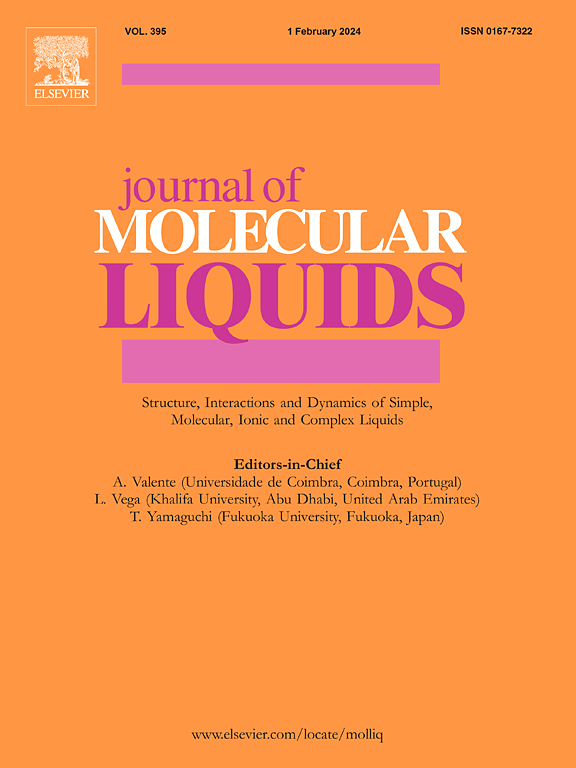COSMO-RS prediction, experimental investigation, and mechanism analysis: A new approach to separating the n-hexane - tert-butanol azeotropic system via liquid-liquid extraction with ionic liquids
IF 5.3
2区 化学
Q2 CHEMISTRY, PHYSICAL
引用次数: 0
Abstract
n-Hexane and tert-Butanol (TBA) are frequently utilized to refine the conditions for Grignard, Wittig, and Friedel-Crafts alkylation reactions. During the synthesis of loratadine, the formation of azeotropic mixtures n-hexane and TBA, which are challenging to separate through conventional distillation, is inevitable. This study utilizes the COSMO-RS model to identify suitable ionic liquids (ILs) for the separation of the n-hexane - TBA azeotropic system. Based on solvent capacity and selectivity, 1-ethyl-3-methylimidazolium trifluoroacetate ([EMIM][TFA]), 1-butyl-3-methylimidazolium trifluoroacetate ([BMIM][TFA]), and 1-hexyl-3-methylimidazolium trifluoroacetate ([HMIM][TFA]) were selected as extractants. The liquid–liquid equilibrium (LLE) data for the n-hexane - TBA - ILs ternary system were measured at 303.15 K and atmospheric pressure. Distribution coefficients and selectivity were calculated to evaluate the performance of the extractants, with the NRTL model used to correlate the experimental LLE data. The consistency of the NRTL model parameters was corroborated through topological analysis associated with the Gibbs tangent principle. Quantum chemical calculations, including interaction energy, ESP analysis, IGMH analysis, and QTAIM topological analysis, were performed to explore the separation mechanism at the molecular level. The results indicated that the interaction energies between the ILs and TBA were higher than those between the ILs and n-hexane, indicating a stronger attraction of ILs to TBA. Consequently, the ILs effectively separated TBA from the n-hexane - TBA azeotropic system, with extraction capacities ranked as [EMIM][TFA] > [BMIM][TFA] > [HMIM][TFA]. The quantum chemical calculations successfully explained the experimental results, aligning with COSMO-RS model predictions and confirming their reliability. IGMH and QTAIM topological analyses systematically explored the types and strengths of interactions, revealing that hydrogen bonds are predominant between the ILs and TBA, with additional contributions from van der Waals forces. Furthermore, the hydrogen bond strengths between TBA and the anions and cations of the ILs are classified as strong and moderate, respectively. This work provides valuable insights into the separation of azeotropic systems using ILs, elucidating the underlying mechanisms behind this process.
COSMO-RS 预测、实验研究和机理分析:利用离子液体进行液-液萃取分离正己烷-叔丁醇共沸体系的新方法
正己烷和叔丁醇(TBA)经常被用来完善格氏、维氏和弗里德尔-卡夫斯烷基化反应的条件。在合成氯雷他定的过程中,不可避免地会形成共沸混合物正己烷和叔丁醇,而通过传统蒸馏法分离这两种混合物非常困难。本研究利用 COSMO-RS 模型确定了适合分离正己烷-TBA 共沸体系的离子液体 (IL)。根据溶剂容量和选择性,选择了1-乙基-3-甲基咪唑三氟乙酸盐([EMIM][TFA])、1-丁基-3-甲基咪唑三氟乙酸盐([BMIM][TFA])和1-己基-3-甲基咪唑三氟乙酸盐([HMIM][TFA])作为萃取剂。在 303.15 K 和大气压力下测量了正己烷 - TBA - ILs 三元体系的液液平衡(LLE)数据。通过计算分配系数和选择性来评估萃取剂的性能,并使用 NRTL 模型来关联 LLE 实验数据。通过与吉布斯正切原理相关的拓扑分析,证实了 NRTL 模型参数的一致性。为探索分子水平的分离机制,进行了量子化学计算,包括相互作用能、ESP 分析、IGMH 分析和 QTAIM 拓扑分析。结果表明,ILs 与 TBA 之间的相互作用能高于 ILs 与正己烷之间的相互作用能,这表明 ILs 对 TBA 具有更强的吸引力。因此,ILs能有效地将TBA从正己烷-TBA共沸体系中分离出来,萃取能力依次为[EMIM][TFA] > [BMIM][TFA] > [HMIM][TFA]。量子化学计算成功地解释了实验结果,与 COSMO-RS 模型的预测一致,证实了其可靠性。IGMH 和 QTAIM 拓扑分析系统地探讨了相互作用的类型和强度,揭示了 IL 与 TBA 之间以氢键为主,范德华力也有贡献。此外,TBA 与 IL 的阴离子和阳离子之间的氢键强度分别被划分为强和中等。这项研究为利用 IL 分离共沸体系提供了宝贵的见解,并阐明了这一过程背后的基本机制。
本文章由计算机程序翻译,如有差异,请以英文原文为准。
求助全文
约1分钟内获得全文
求助全文
来源期刊

Journal of Molecular Liquids
化学-物理:原子、分子和化学物理
CiteScore
10.30
自引率
16.70%
发文量
2597
审稿时长
78 days
期刊介绍:
The journal includes papers in the following areas:
– Simple organic liquids and mixtures
– Ionic liquids
– Surfactant solutions (including micelles and vesicles) and liquid interfaces
– Colloidal solutions and nanoparticles
– Thermotropic and lyotropic liquid crystals
– Ferrofluids
– Water, aqueous solutions and other hydrogen-bonded liquids
– Lubricants, polymer solutions and melts
– Molten metals and salts
– Phase transitions and critical phenomena in liquids and confined fluids
– Self assembly in complex liquids.– Biomolecules in solution
The emphasis is on the molecular (or microscopic) understanding of particular liquids or liquid systems, especially concerning structure, dynamics and intermolecular forces. The experimental techniques used may include:
– Conventional spectroscopy (mid-IR and far-IR, Raman, NMR, etc.)
– Non-linear optics and time resolved spectroscopy (psec, fsec, asec, ISRS, etc.)
– Light scattering (Rayleigh, Brillouin, PCS, etc.)
– Dielectric relaxation
– X-ray and neutron scattering and diffraction.
Experimental studies, computer simulations (MD or MC) and analytical theory will be considered for publication; papers just reporting experimental results that do not contribute to the understanding of the fundamentals of molecular and ionic liquids will not be accepted. Only papers of a non-routine nature and advancing the field will be considered for publication.
 求助内容:
求助内容: 应助结果提醒方式:
应助结果提醒方式:


